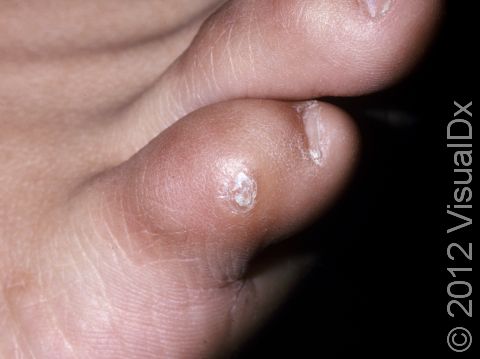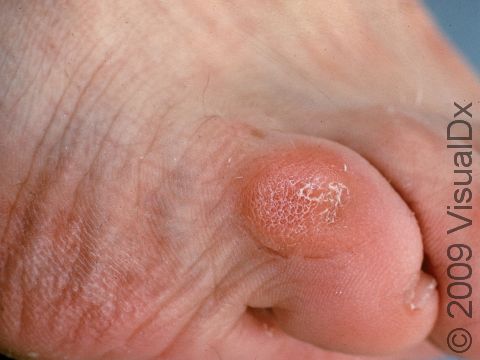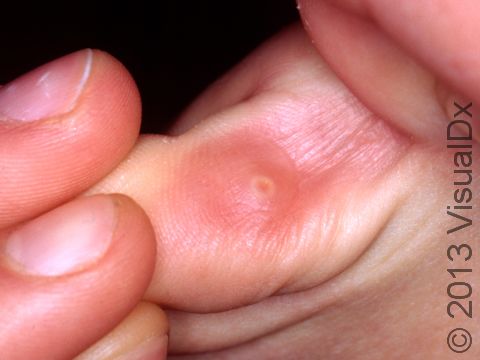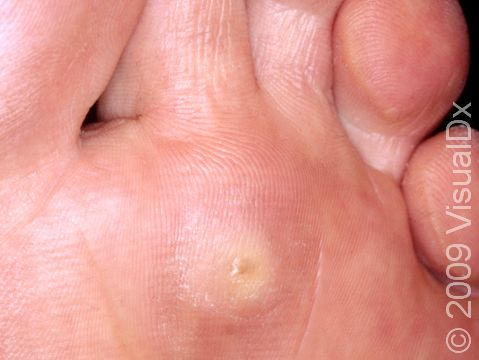Corns
Corns are thickenings of the skin composed of keratin (a type of protein that forms in the hair, skin, and nails). They are typically found on the toes. They are caused by repeated friction or pressure to the involved area.
Corns are considered either hard or soft, depending on their location and appearance.
- Hard corns typically affect the tops or bottoms of the toes and appear as a well-defined, dry, thickened area of skin.
- Soft corns occur between the toes and are whiter, softer, and moister in appearance due to continuous softening by sweat.
Who's At Risk?
People of all ages may develop corns. However, they are most common in those who:
- Wear ill-fitting shoes.
- Do not wear shoes.
- Wear socks that bunch up in their shoes.
- Have foot problems such as crooked toes.
- Do physical activities that cause excess moisture, pressure, and/or friction to the skin.
Signs & Symptoms
Corns are primarily located on the feet, especially the toes. However, corns can appear anywhere that foot friction occurs, including on top of the foot and even on the sole of the foot.
Hard corns typically affect the top or bottom of the toes, the soles, or the side of the fifth toe, and they look very similar to calluses. Hard corns can be extremely painful, as their dense core may press on nerves.
In the case of soft corns, well-defined skin thickening or soft papules (small, solid bumps) may be seen between the toes.
Self-Care Guidelines
To best prevent corns, make sure to wear comfortable shoes that fit properly. Wearing orthotic shoe inserts and keeping the skin moisturized can also help prevent corns. There are also over-the-counter corn pads that help relieve pressure from bony areas such as toe knuckles.
As long as you have no underlying health concerns, such as diabetes, you can try removing corns at home by first soaking your feet in warm water and then rubbing the corn with a pumice stone or nail file. You can then apply an over-the-counter corn pad containing salicylic acid (eg, Compound W, Dr. Scholl’s Corn Removers), repeating and replacing the pad as needed, until the corn goes away.
Treatments
Your medical professional may recommend additional over-the-counter treatments involving good foot hygiene, foot padding, and properly fitting footwear.
Your medical professional may pare down the corn in the office using a blade and may prescribe a keratolytic agent (such as urea cream) to help soften the thickened skin.
If you have corns that continue to come back, corns that don’t resolve with the above measures, or if you have other foot problems such as crooked toes, your medical professional may recommend seeing a podiatrist or orthopedic surgeon.
Visit Urgency
Corns are a common and harmless condition that may not require medical care. However, if corns become very painful or start to grow, seek medical care.
Additionally, individuals with certain medical conditions, such as diabetes or a connective tissue disease, have an increased risk of complications associated with corns; if you have such a condition, seek medical evaluation.
References
Bolognia J, Schaffer JV, Cerroni L. Dermatology. 4th ed. Philadelphia, PA: Elsevier; 2018.
James WD, Elston D, Treat JR, Rosenbach MA. Andrew’s Diseases of the Skin. 13th ed. Philadelphia, PA: Elsevier; 2019.
Kang S, Amagai M, Bruckner AL, et al. Fitzpatrick’s Dermatology. 9th ed. New York, NY: McGraw-Hill Education; 2019.
Paller A, Mancini A. Paller and Mancini: Hurwitz Clinical Pediatric Dermatology. 6th ed. St. Louis, MO: Elsevier; 2022.
Last modified on June 17th, 2024 at 11:02 am

Not sure what to look for?
Try our new Rash and Skin Condition Finder



